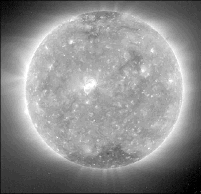5/10/96
CONTACT: David F. Salisbury, News Service (415) 725-1944;
e-mail: david.salisbury@stanford.edu
Looking at the Sun through new eyes
STANFORD -- Craig DeForest has stars in his eyes.
One star, actually the Sun. After he successfully defended his doctoral thesis last August, the young solar physicist landed a job that not only put him at the very center of activity in his chosen field but recently thrust him into the media limelight as well.
DeForest works at NASA's Goddard Space Flight Center in Maryland as liaison for a
30-member Stanford research team operating a key instrument on the European Space Agency's Solar and Heliospheric Observatory (SOHO) the spacecraft that is sending scientists into raptures over its images of the Sun.
Launched from the Kennedy Space Center in Florida in December, the $1.1 billion spacecraft spent its first four months of operation reaching a position 930,000 miles sunward from the Earth and testing and calibrating its battery of 12 scientific instruments. But the solar images that it already has produced have raised scientists' hopes that data from the mission will help solve some longstanding solar mysteries, such as the reason why solar activity varies on an 11-year cycle and what makes the solar corona much hotter than the Sun's surface.
"The images are even better than we hoped," said Philip Scherrer, the Stanford physics research professor who heads the group. He noted particularly the pictures coming back from Stanford's Michelson Doppler Imager, an instrument that simultaneously measures movement of the Sun's surface at a million different points.
On May 2, both the European Space Agency and the National Aeronautics and Space Administration held independent press briefings on SOHO's initial observations, ESA in Paris and NASA at its headquarters in Washington, D.C.
Scherrer participated by videotape in the ESA briefing, which took a comprehensive approach, with each of the dozen principal scientists commenting briefly about what they have seen.
NASA chose to focus on the results of the project's first series of joint observations, a program that DeForest organized. The NASA briefing featured DeForest; Joseph Gurman, the principal investigator on a SOHO solar corona telescope, who participated in the joint observations; and two independent astronomers, Andrea K. Dupree from the Harvard-Smithsonian Center for Astrophysics in Cambridge, Mass., and P. Brendan Byrne from Armagh Observatory in Northern Ireland.
(DeForest's Stanford colleagues, watching the press briefing over NASA' s television network, expressed surprised when he appeared in a tie.)
The young physicist explained that several of SOHO's instruments simultaneously observed a portion of the Sun's south solar pole: a "quiet" region where simple features called solar plumes originate. The images revealed that these plumes which appear to be streams of charged particles that flow straight out into space above the pole are associated with small regions of high magnetic activity on the Sun's surface that rapidly turn on and off. The plumes also appear to be much more dynamic than scientists had thought, he said
This is important because the plumes are among the simplest features on the Sun's surface, DeForest said. As such they represent a natural laboratory for understanding what is heating the solar corona and how the solar wind the stream of electrically charged particles that flow outward from the Sun into the solar system is accelerated.
Gurman added that the initial SOHO images have destroyed the idea, held by many scientists, that in certain areas and at certain times the Sun is quiescent. "Even in the quietest places on the Sun, there is tremendous activity," he said.
The realization that the difference between "quiet" and "active" regions of the Sun is a matter of degree, not kind, must be taken into account in the way that scientists look at stars in general, the two astronomers, Dupree and Byrne, agreed.
The press conferences garnered extensive media coverage, including a stint for DeForest on NBC's "Today," an event he undoubtedly did not anticipate when he accepted the SOHO job.
DeForest received three job offers unusual in his field but the SOHO position, he said, was "an offer I couldn't turn down. After all, SOHO is at the very center of solar physics."
Scherrer, who offered him the SOHO job, said that "we wanted someone who could act as a liaison with the coronal experiments, and Craig had just the right background." DeForest's doctoral adviser was physics Professor Arthur B.C. Walker Jr., who is also involved in SOHO, and his thesis involves observations of the solar plumes made by a rocket-launched ultraviolet telescope.
Watching the first images coming back from SOHO has been "really mind-blowing," DeForest said. In the operations facility at Goddard, the output from each instrument on the spacecraft is channeled to the computers in a different cubicle. As a result, each cubicle has had better pictures of certain aspects of the Sun than have ever been seen before. "Each time you look in one of these rooms," he said, "you can see something totally new."

This image, taken by one of The Solar and Heliospheric Observatory's ultraviolet telescopes, shows the Sun's corona, which is heated to 1.5 million degrees Celsius. No one knows why the corona is a million degreees hotter than the Sun's surface, but SOHO's observations of solar plumes, the whisker-like features sticking out from the dark region at the Sun's south pole, may help scientists solve this longstanding mystery.
Credit: European Space Agency/National Aeronautics and Space Administration
-dfs-
960510solarlook.html
Download this release and its related files.
The release is provided in Adobe Acrobat format. Any images shown in the release are provided at publishing quality. Additional images also may be provided. Complete credit and caption information is included.
960510solarlook.sit